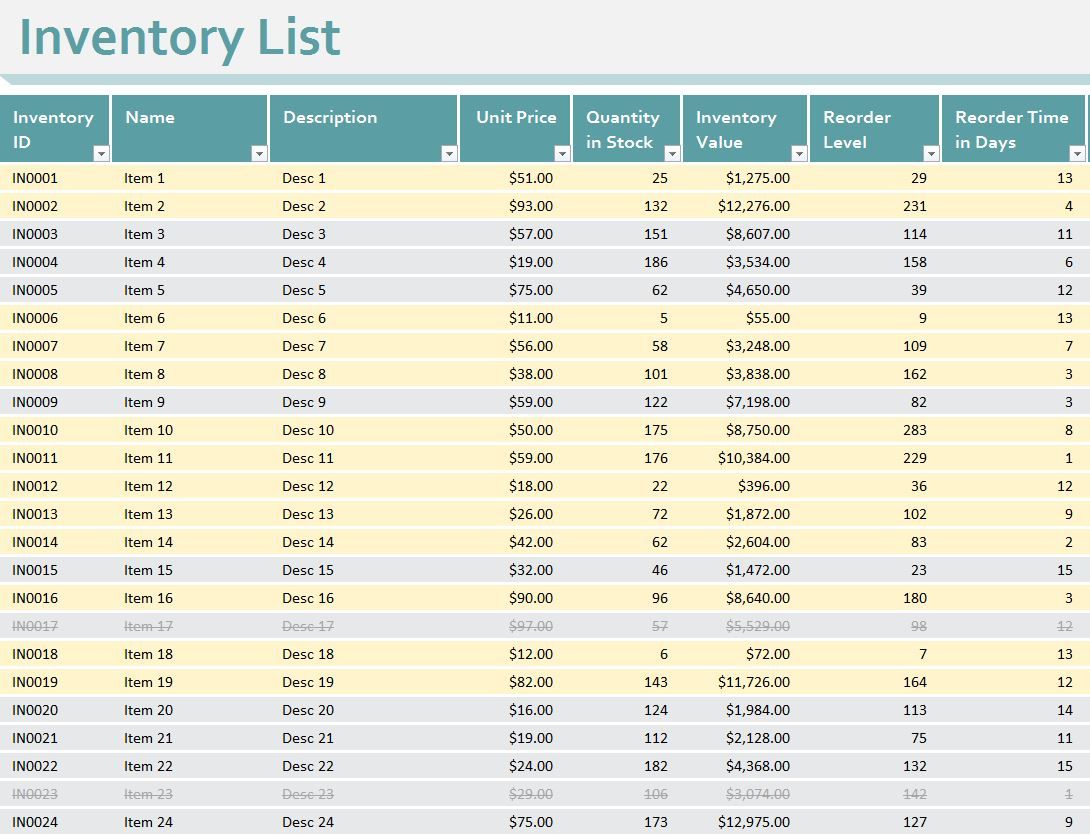Maintain Stock Efficiently Using Excel Sheets

The effective management of inventory is vital for any business looking to reduce costs, enhance cash flow, and improve overall operational efficiency. One of the best tools at your disposal for this purpose is Microsoft Excel. Its powerful features can be harnessed to maintain stock levels accurately, track inventory turnover, and streamline your inventory processes. Here’s an in-depth guide on how to use Excel to efficiently manage your stock.
Setting Up Your Excel Sheet

Before diving into complex formulas and data analysis, the first step is to establish a clean and organized Excel sheet. Here are the steps:
- Open a new Excel workbook.
- Name your first sheet "Stock Inventory."
- Create columns for critical inventory data like:
- Product ID
- Product Name
- Category
- Description
- Cost Price
- Selling Price
- Stock Quantity
- Reorder Point
- Minimum Stock Level
- Supplier Information
💡 Note: Always format numbers as currency or integers where necessary to ensure accuracy in calculations.
Tracking Stock Movements

To keep your stock levels updated, track every movement with:
- Receipts: Use Excel's table format to record every stock receipt from suppliers. This should include the date, product ID, quantity received, and cost price.
- Issues: Similarly, create a section for tracking when items are issued or sold. Record the date, product ID, quantity issued, and selling price.
- Adjustments: Sometimes stock levels need manual adjustments due to damage, theft, or errors. Keep a record of these adjustments for an accurate inventory.
Here's an example table for tracking:
| Date | Product ID | Type | Quantity | Price |
|---|---|---|---|---|
| 01/01/2023 | PROD001 | Receipt | 20 | $100.00 |
| 01/03/2023 | PROD001 | Issue | 10 | $150.00 |

📝 Note: Regularly back up your Excel file to avoid data loss. Consider using cloud storage for real-time backups.
Automating Stock Management with Formulas

Excel's real power comes from its ability to automate calculations:
- Current Stock Level: Use a formula like =SUM(Receipts)-SUM(Issues) to calculate the current stock level for each product.
- Reorder Notification: Implement a conditional formatting rule that highlights cells when stock levels drop below the reorder point.
- Projected Stock Level: Utilize forecasted sales data to predict when stock will run low with a formula like =[Current Stock Level] - (Projected Sales * Average Daily Sales).
Analyzing Inventory Data

Inventory management is not just about tracking numbers; it's also about making strategic decisions based on data:
- Turnover Rate: Calculate how quickly items are sold and replaced. A formula could be =Total Sales in Period / Average Inventory During Period.
- ABC Analysis: Categorize inventory into A, B, and C items based on value to determine which items require more intensive management.
| Product ID | Category | Annual Sales Value | ABC Category |
|---|---|---|---|
| PROD001 | High-end Electronics | $150,000 | A |
| PROD002 | Hardware Supplies | $5,000 | C |
By applying these techniques, businesses can better understand their stock's performance and make informed decisions on restocking, sales promotions, or even discontinuing certain items.
📊 Note: Use pivot tables to summarize and analyze large data sets for visual insights into your inventory.
In summary, Excel offers a flexible and powerful platform for managing stock levels. By setting up a structured Excel sheet, tracking stock movements meticulously, employing automation through formulas, and leveraging data analysis, you can achieve a streamlined inventory process that reduces costs, improves efficiency, and enhances customer satisfaction. Remember to keep your data backed up, regularly update your records, and utilize Excel's analytical tools to get the most out of your inventory management system.
What are the benefits of using Excel for inventory management?

+
Excel offers customization, automation through formulas, visual data analysis, cost-effectiveness, and the ability to integrate with other systems, making it an excellent tool for inventory management.
Can Excel handle large inventory databases?

+
Excel can manage large datasets, but for very large inventories, consider using Power Query for data management or exploring database solutions like SQL.
How often should I update my stock inventory in Excel?

+
Update your inventory records at least daily or in real-time if your business’s volume of sales and stock movements justifies it.
Is it necessary to back up my Excel inventory data?

+
Yes, regular backups are crucial to prevent data loss due to file corruption or hardware failure. Consider cloud backups for added security.



